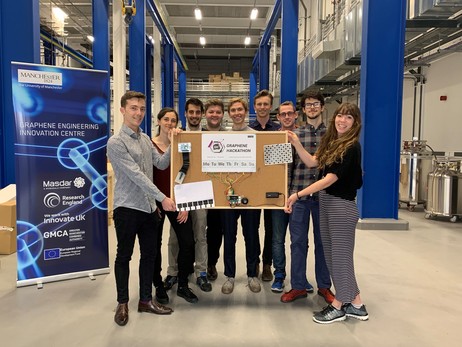Open Innovation Contest to Discover New Uses For a Revolutionary Material
Published Dec-20-19Breakthrough:
A graphene ink sensor that could be used to check on crop health by analyzing soil solutions.
Company:
Liquid Indentity, United Kingdom
The Story:
 Graphene is the new wonder material, a carbon sheet that is one atom thick but 200 times stronger than steel. It stretches, twists, rolls and is the lightest, most conductive manmade material on Earth. The remarkable electronic, mechanical and chemical properties of Graphene at the molecular scale confer on it an almost limitless potential. According to the hype, it is set to transform multiple sectors such as energy, health, construction and electronics.
Graphene is the new wonder material, a carbon sheet that is one atom thick but 200 times stronger than steel. It stretches, twists, rolls and is the lightest, most conductive manmade material on Earth. The remarkable electronic, mechanical and chemical properties of Graphene at the molecular scale confer on it an almost limitless potential. According to the hype, it is set to transform multiple sectors such as energy, health, construction and electronics.As the name suggests, Graphene comes from graphite which is used in lead pencils. The revolutionary material was first extracted in 2004 by Profs Andre Geim and Konstantin Novoselov from Manchester University. They did it by removing carbon flakes from graphite using bits of sticky tape. For their pioneering research, they were awarded the Nobel Prize for Physics in 2010.
Among the many potential graphene applications are ultra-fast transistors for electronics, touch-sensitive smart devices, bendable phones, flexible wearable electronics, more efficient and longer-lasting LED, faster DNA sequencing, drug delivery and more.
Exploiting Potential
To exploit the potential of this new material, the University of Manchester in the UK hosted the world's first graphene hackathon. During this 24-hour event, ten multidisciplinary teams from across the UK and Europe worked on developing prototype products using graphene inks.
The principal aims of the open innovation event were to promote the use of Graphene and to make it more accessible to those looking to explore its potential. Organizers also wanted insights from multiple perspectives.
"We want to encourage as diverse a skillset as possible to engage with the material, bringing fresh perspectives and ideas," said Vicente Orts Mercadillo, PhD student in Graphene & 2D Materials at The University of Manchester.
Teams were given access to graphene-based technology and screen printing facilities and a hackathon kit that contained everyday items such as paints and brushes as well as a Raspberry Pi microcomputer. Then the creativity got underway and teams ideated, printed, wired and coded their ideas through the night. Experts from numerous disciplines were on hand to assist.
Novel Ideas
Toward the end of the hackathon, the teams pitched their prototypes to a panel of judges. They chose three winners:
• In first place was Liquid Identity, a low-cost graphene ink sensor that could be used to analyze soil solutions to check on crop yield and health. The team behind it won up to £5,000 (approx. USD $6,450) of support, materials and mentoring from the GEIC (Graphene Engineering Innovation Center) to help turn their prototype into a product.
• Second place went to BackUp, a seat cover with ink printed strain sensors that could determine and advise freight drivers on healthy back posture.
• Glovene came third and picked up the £250 innovation prize for a set of gloves that uses accelerators and impedance measurements across graphene tracks to interpret sign language in real time.
Next Story »


